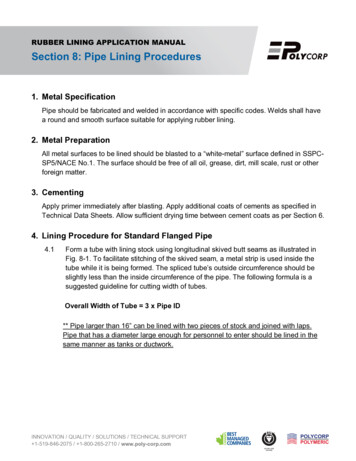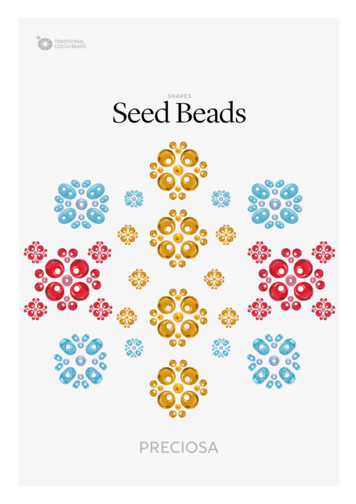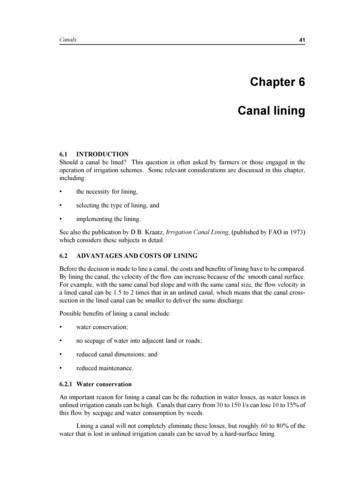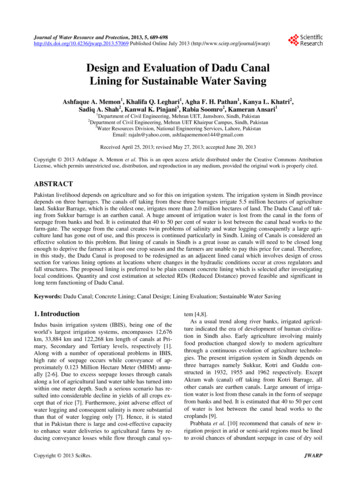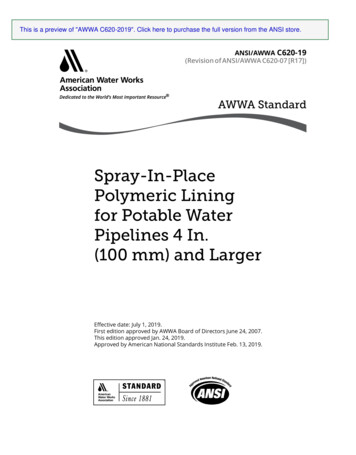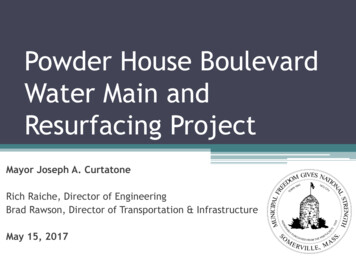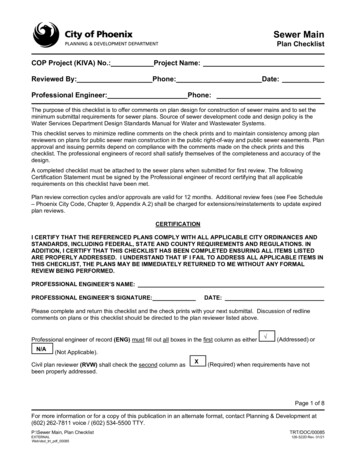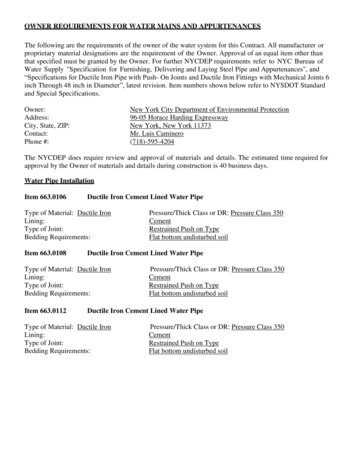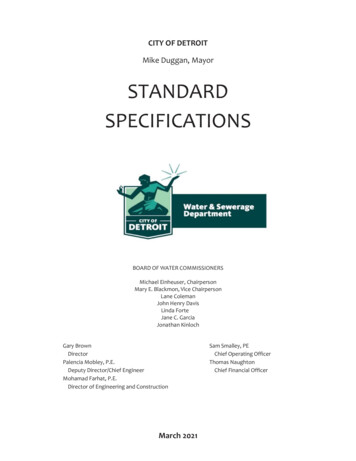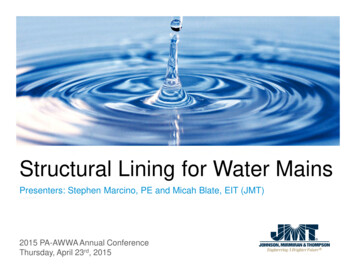
Transcription
Structural Lining for Water MainsPresenters: Stephen Marcino, PE and Micah Blate, EIT (JMT)2015 PA-AWWA Annual ConferenceThursday, April 23rd, 2015
1. Introduction2. Purpose of Lining3. Lining HistoryAgenda1. Spray-on2. CIPP4. Classifications of Liners5. Spray-on Structural Liners Example Manufacturers6. Cured-in-Place Pipe Liners Example Manufacturers7. Conclusion
Introduction Aging infrastructure Alternate to open-cutmethodology– Trenchless technology Limited resources andcapital Structural Lining– Less intrusive– Potentially less Cost Two primary types:– Spray-on– Cured-in-place pipe(CIPP)Image provided by NY Times
Purpose of Lining Objectives of Lining mayinclude:––––––Improve water qualityStop water loss/leaksStructurally renew existing pipelineImprove hydraulic characteristicsExtend service life of pipelineReduce costImage courtesy of Ellingson Companies
Lining History – Spray-on Cement Mortar Lining– First used in 1830s¹– Non-structural Structural Lining– Epoxy implemented in UK in1985– US approval in 2008 viaANSI/AWWA C620-07 Standard(Spray-applied in-situ epoxylining)Image courtesy of Thortex (epoxycoating application)¹According to Water Research Foundation (WRF)
Lining History – CIPP CIPP¹– Pipe within a pipe– First implemented in 1971 inLondon, named insit u form(Latin for “form in place”)– Originally felt tube saturated withresin– Patent issued 1977 andcommercialized by Insituform Technologies– Patent expired in 1994Image courtesy of GML Coatings, LLC¹Artice: Evolution of Cured-in-Place Pipe Allows Structural Renewal of Drinking Water Pipe, David Kozman, PE
Classifications of Liners AWWA developed classification system todescribe and differentiate among linings– Class 1 Non-structural Coating/corrosion protection– Class 2 Semi-structural – pressure transferred to host pipe Requires adhesion to host pipe– Class 3 Semi-structural – pressure transferred to host pipe Does not require adhesion to host pipe– Class 4 Fully-structural Independent of host pipe Pipe within a pipe
Spray-On StructuralLiners
Spray-on Structural Liners Process Overview––––Pre-inspectionIsolate segmentRequires two access pointsApplication rig pushed into position andwinched backwards while nozzle headapplies material to pipe– Post-inspectionImage courtesy of trenchless-pipelining
Spray-on Structural Liners Advantages– Minimal effort to re-establishservice connections– Minimize disruptions tocommunity due to minimalaccess pits compared to opencut– Typical maintenance/repairmethods can be applied tocompleted pipelines Limitations– Voids and blisters may form ifpipe is not properly prepared– Potential for uneven liner due torig issues– Material can slump on invert ofpipeImage courtesy of Municipal Sewer andWater Magazine
Spray-on Structural Liners – ExampleManufacturers Quest Inspar PipeArmor – Installation sizes: 6 – 174 Inches (any pipe material)– Material 100% Polyurea––––––Installed by Quest Inspar 0.020 inch thicknessDesign standards: ASTM D-192AWWA class IV designation (fully structural)Product Certifications: NSF/ANSI 61 StandardService Connections: Service connections are not blocked during the liningprocess.– Maximum lining distance: 900 LF in each direction (upstream/downstream)at one timeImage courtesy of Quest Inspar
Spray-on Structural Liners – ExampleManufacturers 3M Skotchkote Renewal Liner 2400– Installation sizes: 4 – 24 Inches (DI and CI)– Material 100% Polyurea– Requires authorized applicator contractor– 0.05 inch to 0.3 inch thickness– Design Standards: ASTM F 1216-09, D638-08, D2990-08, and D1599-99 Non-designated fully structural lining (designed to operational pressure and externalloads and conforming to above-referenced standards)– Product Certifications: NSF/ANSI 61 Standard– Service Connections: Service connections are not typically blocked during thelining process. If they are, a mechanical robot can reinstate them.– Maximum lining distance: 600 LF at one timeImage courtesy of 3M
CIPP StructuralLiners
CIPP Structural Liners Process Overview– Liner tube “wetted-out” with resin before inserted into host pipe– Cured utilizing hot water, steam, or UV Advantages– Minimum disturbance to community– Line through bends and non-circular shapes (oval, elliptical, etc.)– VOC free Disadvantages– Like spray-on, bypass or isolation of line required– Requires temperature monitoring of materials prior to installation– Typically requires certified installersImage courtesy of Trenchless International
CIPP Liner – Example Manufacturers Aqua Pipe ––Installation sizes: 6 – 24 Inches (CI, Steel, orDI)Materials, 3 layers: ––––Outer Layer: Semi-Porous synthetic woven polyester(proprietary)Propriety resinInside: Thermal Polyurethane MembraneRequires licensed installers. Licensingincludes rigorous training and equipmentpurchase.Design Standards: ASTM F1216 and ASTM1743AWWA Class IV DesignationProduct Certifications: NSF/ANSI Standard 61,UL, NQ 3660-950, and WRAS¹¹ ApprovedMaterial¹ Water Regulations Advisory SchemeImage courtesy of Aqua Pipe
CIPP Liner – Example Manufacturers Aqua Pipe –Installation:1. The woven synthetic polyester jackets are impregnatedon site,2. The jacket is pulled in place through the host pipe.3. Because the outer layer of the liner is semi-porous, theresin seems through it, allowing adhesion to the hostpipe.4. The final step includes circulating hot water through thepipe for curing purposes.––Service Connections: Following installation amechanical robot reinstates service laterals.Maximum Installation Length: 1,000 LF at one timeImages courtesy of Aqua Pipe
CIPP Liner – Example Manufacturers SEKISUI NordiPipe – Installation sizes: 6 – 48 Inches– Materials, 4 layers: PE CoatingNeedled FeltGlass FiberEpoxy Resin– Requires licensed installers. Licensingincludes rigorous training andequipment purchase.– Design Standards: ASTM D638, D790– AWWA Class IV Designation– Product Certifications: NSF/ANSI 61StandardImage courtesy of SEKISUI
CIPP Liner – Example Manufacturers SEKISUI NordiPipe – Installation: The liner is impregnated on site, in a climate controlled environment, with an epoxyresin. Once prepared, the liner is inverted into place and cured with steam or heatedwater.– Service Connections: Following installation a mechanical robotreinstates service laterals.– Maximum installation length: 500 LF at one timeImages courtesy of SEKISUI
CIPP Liner – Example Manufacturers Insituform InsituMain – Installation sizes: 6 – 60 Inches (CI, DI,Steel, Cement, RCP, Plastic)– Materials, 3 layers: Polyester Fiber Fiberglass Epoxy Resin– Design Standards: ASTM F1216 and ASTMF1743– AWWA Class IV Designation– Product Certifications: NSF/ANSI 61StandardImage courtesy of Insituform
CIPP Liner – Example Manufacturers Insituform InsituMain – Installation: The composite material is impreganated on or off-site with an epoxy resin. The pipe is installed into the pipe witheither an inverted or pull-in method (either direction). To cure the material, steam or heated water is circulatedthrough the pipe.– Service Connections: Following installation a mechanical robot reinstatesservice laterals.– Maximum installation length: 1,500 LF at one timeImage courtesy of Insituform
Conclusion and Summary nufacturerSEKISUINordipipe (Class IV)Aqua-Pipe (Class IV)Pipe Size(in.)ApproximateCost (Per LF)*6 – 48 100- 1256 – 24 105- 125MaterialsWovenpolyester andpolyurethaneNeedled felt,glass fiber,epoxy resinInsituformInsituMain (Class IV)6 – 60 120- 140Polyester fiber,fiberglass,epoxy resin3mSkotchtite (Class III)4 – 24 125- 140PolyureaQuest InsparPipe Armor (Class IV)6 – 174 120 – 135PolyureaBenefits Fast installationMinimum surfacedisruptionMinimum annular spacebetween host pipe andliner (no grouting required)Increased Hazen-WilliamsC-factorVOC freeCost-effectiveQuick cure-timeLittle to no effort requiredfor service connection reestablishmentMinimal surface disturbanceCost-effectiveTypical maintenance/repairapplicable followinginstallationDisadvantages Certified installers notavailable in every areaInternal pressure ratinglimitationsMaterials need to bemonitored fortemperatureBend limitationsLimited number ofinstallers/manufacturersPotential defects of linerdue to applicator issuesMaterial may slump ininvert of pipe* Approximate installed costs for 6-inch pipe designed to a structural level. Costs can vary greatly depending upon specific sitelocation, total length of pipe, condition of host pipe, installer, amount of bends and fittings and water service connections.
Questions?
Structural Lining for Water Mains 2015 PA-AWWA Annual Conference Thursday, April 23rd, 2015. 1.Introduction 2.Purpose of Lining 3.Lining History 1.Spray-on 2.CIPP 4.Classifications of Liners 5.Spray-on Structural Liners . Microsoft PowerPoint - Water Main lining.pptx Author: mblate
